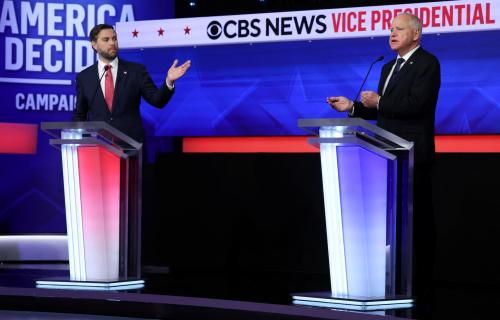What’s the latest thinking in fiscal and monetary policy? The Hutchins Roundup keeps you informed of the latest research, charts, and speeches. Want to receive the Hutchins Roundup as an email? Sign up here to get it in your inbox every Thursday.
Expanded Child Tax Credit had little negative effect on labor force participation
The American Rescue Plan temporarily increased the generosity of the Child Tax Credit (CTC) and made it fully refundable. Early evaluations suggest that this expansion reduced child poverty and food insecurity across the U.S., but little is known about the effects on labor force participation. Using survey data from April to December 2021, Elizabeth Ananat of Barnard College and co-authors compare the labor market engagement of eligible and ineligible households, as well as those receiving varying credit amounts. Contrary to speculation that families receiving the credit might work less, they find only small and statistically insignificant impacts of the tax credit on both employment and labor force participation. In particular, families who earned under $25,000 before the expansion, for whom full refundability eliminated an incentive to work, responded no differently than higher-income families. “Real-world data suggest that the expanded CTC did not have negative short-term employment effects that offset its documented reductions in poverty and hardship,” the authors say. Given the unusually strong incentives for parents to work less during the COVID pandemic, they argue these effects would be even lower in non-pandemic years if the expansion were to be made permanent.
Minimum wage increases do not drive wage gains for low-wage workers
Increases in state minimum wages account for a modest fraction of the wage gains experienced by minimum wage workers, find Jeffrey Clemens of the University of California, San Diego, and Michael Strain of the American Enterprise Institute. Using data from the Current Population Survey, the authors find that among states that increased their minimum wage at least once over the 2010-2019 period, minimum wage increases accounted for just 8% of the wage gains realized by minimum wage workers. About 79% of minimum wage workers living in states that increased their minimum wage received a raise in a given year, compared to 71% in states that did not increase the minimum wage, the authors find. Macroeconomic factors (such as labor market tightness) and workers’ career progression (such as changing occupations) account for the majority of raises received by minimum wage workers. The findings suggest that “minimum wage increases play a modest role as a driver of earnings trajectories beyond shaping the initial, typically short-lived, minimum wage job itself,” the authors conclude.
Labor and capital tax rates have converged globally
Since 1965, the effective tax rates on labor and capital have converged internationally, find Pierre Bachas of the World Bank and co-authors. The authors construct a global database of national income components and public revenues covering over 50 years and 150 countries, harmonizing data from the International Centre for Tax and Development, OECD, IMF, United Nations, and archival records. They then compute the effective tax rates on labor (e.g. payroll taxes, social security contributions, and the labor share of personal income taxes), and capital (e.g. corporate income, wealth, and property taxes and the capital share of personal income taxes) by dividing tax revenues by the size of the respective tax bases in each country. Using three different empirical research designs, the authors find that, in high-income countries, trade openness has reduced capital taxation, as higher global competition has prompted a “race to the bottom” in corporate tax rates. They find the opposite effect in developing countries. In these low- and middle-income countries, the authors explain, globalization has led to more formal corporate structures, increasing governments’ capacity to recognize and tax capital income. Across all countries, the authors find that trade openness has increased rates of labor taxation, driven largely by growth in payroll taxes. The authors suggest that this trend may result from workers’ demands for social safety net programs to counter the economic fluctuations induced by globalization.
Chart of the week: While Global Supply Chain Pressures Are Decreasing, Pressure Still Remains High
Chart courtesy of The New York Fed
Quote of the week:
“[T]here is little monetary policy can do to address factors that have only temporary effects on inflation – affecting the near-term outlook, but not the outlook for inflation at the policy-relevant horizon. The energy price surge is an example of such a temporary shock. It will lift inflation (and lower real wage growth) for a period. But, unless energy prices go on rising or inflation expectations are destabilized, it is unlikely to generate a sustained inflation overshoot. It would not make sense (and would not be consistent with our remit) to tighten policy so much as to try to return inflation to the 2% target in the next few months, when the temporary effect of energy prices is at its peak,” says Michael Saunders, Member, Monetary Policy Committee of the Bank of England.
“This does not mean the MPC [Monetary Policy Committee] has abandoned its commitment to low inflation. It is a recognition of the fact that 2% inflation could only be achieved in the next few months by tightening policy very sharply in order to weaken the economy enough to quickly push non-energy inflation well below a target-consistent pace. This would cause undesirable volatility in output and jobs. And, given that the full effect of those monetary policy changes would occur after the energy effect fades, it would leave inflation well below the 2% target further ahead… [T]he role of monetary policy is to ensure that inflation expectations are well anchored and that domestic cost and capacity pressures are consistent with a return of inflation to the 2% target over time as the effects of the energy price surge fade.”
The Brookings Institution is financed through the support of a diverse array of foundations, corporations, governments, individuals, as well as an endowment. A list of donors can be found in our annual reports published online here. The findings, interpretations, and conclusions in this report are solely those of its author(s) and are not influenced by any donation.









Commentary
Hutchins Roundup: Child tax credit, minimum wages, and more
March 10, 2022